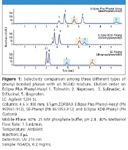Comparing Selectivity of Phenylhexyl and Other Types of Phenyl Bonded Phases
The Application Notebook
A new phenylhexyl bonded phase provides an alternative selectivity for optimizing HPLC method. This also applies when different types of phenyl bonded phases are compared.
A new phenylhexyl bonded phase provides an alternative selectivity for optimizing HPLC method. This also applies when different types of phenyl bonded phases are compared.
Selectivity is the most powerful tool to optimize separations in HPLC. This parameter is changed by using different bonded phases including C18, C8, CN, and Phenyl bonded phases. Phenyl bonded phases are known for their improved selectivity for aromatic compounds. There isn't just one phenyl column, in fact there are a variety of ways of bonding phenyl onto a silica surface and each type of phenyl column can have unique selectivity.
Experimental
A new Agilent ZORBAX Eclipse Plus Phenyl-Hexyl bonded phase was used to separate a variety of NSAIDs (non-steroidal anti-inflammatory drugs) which all contain from one to three aromatic rings. The separation on this endcapped phenylhexyl bonded phase was compared to two other phenyl type bonded phases. These bonded phases differed from the phenylhexyl by using two phenylethyl bondings: an endcapped and a non-endcapped phase. The ZORBAX SB-Phenyl and the ZORBAX Eclipse XDB-Phenyl use the same base silica and the Eclipse Plus Phenyl-Hexyl uses a slightly modified silica.
All columns used the same mobile phase and sample to evaluate selectivity differences between the phenyl columns.
Results and Discussion
Phenyl columns are a very popular choice for an alternate selectivity to maximize resolution in HPLC separations. There are however, several types of phenyl columns available and they all have unique selectivity, providing an excellent opportunity to optimize separations.
Figure 1 shows the separation of NSAIDs, which is a mixture of aromatic and polyaromatic compounds on three different phenyl columns with unique properties. Each column separates the NSAID mix differently using the same operating conditions.

Figure 1
The Eclipse Plus Phenyl-Hexyl resolves all components at more than baseline resolution making this the best choice for this method. The Eclipse XDB-Phenyl, shows decreased retention of most compounds, which may be attributed to the shorter linkage group, but also results in a rearrangement of the elution order. This selectivity difference can be used to advantage especially when analyzing impurities. Finally a completely different elution pattern is derived with the SB-Phenyl. It has a phenylethyl linkage, but also possesses larger side chains (diisopropyl verses dimethyl) which may make the bonded phase more hydrophobic. In addition, the bonded phase is not endcapped, leaving exposed silanols to interact with ionic compounds.
Conclusions
The three phenyl columns examined showed selectivity differences as a result of all aspects of these phenyl phases, including the endcapping, the alkyl linkage length (ethyl vs. hexyl) and the silica. These variations of phenyl bonded phases provide unique selectivity options and the ability to optimize more separations. The Agilent ZORBAX Eclipse Plus Phenyl Hexyl shows enhanced resolution in polyaromatic sample mixes and is an excellent choice for alternative selectivity.

Agilent Technologies Inc.
2850 Centerville Road, Wilmington, DE 19808-1610
Tel: 302-227-9770; Fax: +1 866-422-5571


.png&w=3840&q=75)

.png&w=3840&q=75)



.png&w=3840&q=75)



.png&w=3840&q=75)













